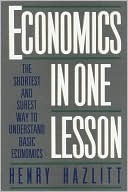More on this book
Community
Kindle Notes & Highlights
Read between
September 25 - October 30, 2021
The effect of keeping interest rates artificially low, in fact, is eventually the same as that of keeping any other price below the natural market. It increases demand and reduces supply.
On the supply side, the artificial reduction of interest rates discourages normal thrift, saving, and investment.
Almost the whole wealth of the modern world, nearly everything that distinguishes it from the pre-industrial world of the seventeenth century, consists of its accumulated capital.
It reduces the costs of goods to consumers, and it increases the wages of the labor that uses the new equipment because it increases the productive power of that labor.
(until about 1960) American motorcar makers could undersell the rest of the world, because their unit cost was lower. And the secret was that the capital used in making American automobiles was greater per worker and per car than anywhere else in the world.
ECONOMICS, as we have now seen again and again, is a science of recognizing secondary consequences. It is also a science of seeing general consequences. It is the science of tracing the effects of some proposed or existing policy not only on some special interest in the short run, but on the general interest in the long run.
When they say that the way to economic salvation is to increase credit, it is just as if they said that the way to economic salvation is to increase debt:
when we study the effects of various proposals, not merely on special groups in the short run, but on all groups in the long run, the conclusions we arrive at usually correspond with those of unsophisticated common sense.
depth in economics consists in looking for all the consequences of a policy instead of merely resting one’s gaze on those immediately visible.
it is difficult to think of a greater fulfillment of any human need which would not, at least temporarily, hurt some of the people who have made investments or painfully acquired skill to meet that precise need.
But the solution is never to reduce supplies arbitrarily, to prevent further inventions or discoveries, or to support people for continuing to perform a service that has lost its value.
This is the insane doctrine of wealth through scarcity.
For many things that seem to be true when we concentrate on a single economic group are seen to be illusions when the interests of everyone, as consumer no less than as producer, are considered.
To see the problem as a whole, and not in fragments: that is the goal of economic science.
One of the worst results of the retention of the Keynesian myths is that it not only promotes greater and greater inflation, but that it systematically diverts attention from the real causes of our unemployment, such as excessive union wage-rates, minimum wage laws, excessive and prolonged unemployment insurance, and overgenerous relief payments.
Coincident with the extraordinary growth of these welfare expenditures has been the development of a “national welfare industry,” now composed of 5 million public and private workers distributing payments and services to 50 million beneficiaries.
It never worked out that way.
The typical political ploy was to load up benefits in the present and push costs into the future.
The American Social Security system must stand today as a frightening symbol of the almost inevitable tendency of any national relief, redistribution, or “insurance” scheme, once established, to run completely out of control.
In brief, the main problem we face today is not economic, but political.
Practically all government attempts to redistribute wealth and income tend to smother productive incentives and le...
This highlight has been truncated due to consecutive passage length restrictions.
Government’s main economic function is to encourage and preserve a free market.
More and more people are becoming aware that government has nothing to give them without first taking it away from somebody else—or from themselves.


